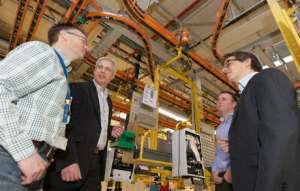BOSCH Nefit
Realistic simulation makes Lean production line more flexible

“Previously, we only looked at the logistics in simulations,” says Gezienus Hoving, plant manager at Nefit. However, it proved that improvements ideas were hard to achieve with existing production equipment. In addition, the deployment took long or required great investments. ‘In cooperation with Hollander Techniek and simulation specialist Ergo-Design, a totally new approach was chosen. The simulation was directly connected to the process computers, the PLCs. In this way, a data set of real production data was created. These numbers were then used as input for the simulation, in which the behaviour of the PLC was also simulated. The result: a model as realistic as a flight simulator in the aircraft industry! This lets you know that solutions will work almost 100% certainly, and what is needed in terms of production equipment. The project received funding from the innovation network of the Stedendriehoek region. Companies such as Auping and Aldipress gave comments from the sidelines.
Cost Savings
At the end of Nefit’s assembly line there are six parallel test stations. Boilers could catch up to each other after at that location, so that a sorting station was required in order to restore the original production sequence. “Our first simulation was the omission of the sorting station,” continues Hoving. “This is possible if you give all test drives a fixed cycle time of six minutes. An operator is indeed no longer able to build up a time buffer, but the simulations showed that this was unnecessary. “The result: a shorter lead time and more space.” And considerable cost savings, because it also means less required manpower.”


